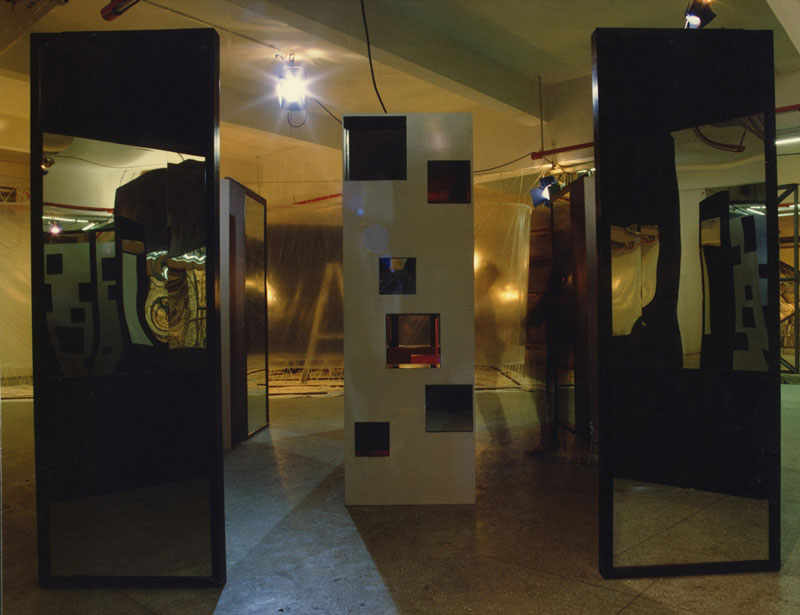Contemporary Chinese Art- another kind of view
DSL Collection
entering the project
More information on the works
More information on the works
Space, Meaning and Their Transitional Exchange
Ever since his first installation of several serpentine walls with reflective mirrors at the No. 1 Workers' Cultural Palace in Guangzhou in 1991, Liang Juhui adhered closely to the creation of spatial forms. Irrespective of the size of the wall faces and frames he created for exploited, the installations invariably carried the ambiance of a playground, He did not attempt at ambivalent messages, as the titles of his works were often related to 'playing' and 'happiness'. While people who subscribe to the 'Litotes' of avant-garde art play question his motive in doing 50, they cannot resist the temptation to go inside these spaces, or the attempt to touch them solely for the sense of novelty, because being inside is just too much fun,
For example, when people walked through the 'Safe Passage' that traversed the corridor of an art museum, they soon found a total breakdown of the functions of the museum, followed immediately by a sense of disorientation. A similar sense of disorientation was discovered with his earlier 'Paradise I Paradise Il', People want to ask: are such installations supposed to carry certain implications? Contemporary art seldom concedes a work of art to purely formal terms, 50 guess work is presumably the necessary first step of 'looking'. However, when Liang Juhui realised that the inevitable denouement, Like a strong draught wheezing through the hallway, was sending the tightly-screwed frames and the dangling iron sheets rumbling and clanging, he proceeded to Lay open the answers and show the hidden meanings: this is desire, that is repression, happiness is the passion of the victimised .And such candid explanations have unexpectedly strengthened the visual allure of his works.
In the 2002 China Pingyao International Photography Festival, Liang put a flight of stairs with thirty steps at the side of a building to good use: he correlated the city view fin its present continuous tense) with ancient buildings in the past tense) to form a staircase to heaven compounded with images. As the series of thirty photographs all showed groups of commuters walking in queue, they gave the illusion that they were identical, but actually they were not. 50 as the people walked up, a mirror effect was created: the images did not stop as they should have; the images augmented; the images were bidding goodbye to their era; and finally, the images became a profile of our reality.
With this forward-thrusting, ascending momentum, we discover that Liang's choice of image touches, without exception, on our established visual experience. In other words, at the first Level of his works, the convincing elements have 'something to do with visual experiences. ....
Chen Dong, Borges Libreria Art Space Trust
Ever since his first installation of several serpentine walls with reflective mirrors at the No. 1 Workers' Cultural Palace in Guangzhou in 1991, Liang Juhui adhered closely to the creation of spatial forms. Irrespective of the size of the wall faces and frames he created for exploited, the installations invariably carried the ambiance of a playground, He did not attempt at ambivalent messages, as the titles of his works were often related to 'playing' and 'happiness'. While people who subscribe to the 'Litotes' of avant-garde art play question his motive in doing 50, they cannot resist the temptation to go inside these spaces, or the attempt to touch them solely for the sense of novelty, because being inside is just too much fun,
For example, when people walked through the 'Safe Passage' that traversed the corridor of an art museum, they soon found a total breakdown of the functions of the museum, followed immediately by a sense of disorientation. A similar sense of disorientation was discovered with his earlier 'Paradise I Paradise Il', People want to ask: are such installations supposed to carry certain implications? Contemporary art seldom concedes a work of art to purely formal terms, 50 guess work is presumably the necessary first step of 'looking'. However, when Liang Juhui realised that the inevitable denouement, Like a strong draught wheezing through the hallway, was sending the tightly-screwed frames and the dangling iron sheets rumbling and clanging, he proceeded to Lay open the answers and show the hidden meanings: this is desire, that is repression, happiness is the passion of the victimised .And such candid explanations have unexpectedly strengthened the visual allure of his works.
In the 2002 China Pingyao International Photography Festival, Liang put a flight of stairs with thirty steps at the side of a building to good use: he correlated the city view fin its present continuous tense) with ancient buildings in the past tense) to form a staircase to heaven compounded with images. As the series of thirty photographs all showed groups of commuters walking in queue, they gave the illusion that they were identical, but actually they were not. 50 as the people walked up, a mirror effect was created: the images did not stop as they should have; the images augmented; the images were bidding goodbye to their era; and finally, the images became a profile of our reality.
With this forward-thrusting, ascending momentum, we discover that Liang's choice of image touches, without exception, on our established visual experience. In other words, at the first Level of his works, the convincing elements have 'something to do with visual experiences. ....
Chen Dong, Borges Libreria Art Space Trust

